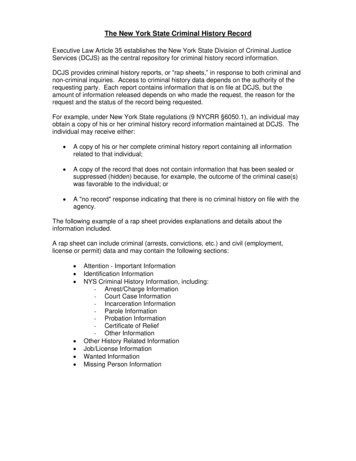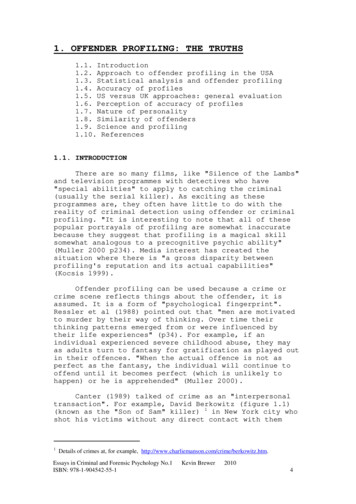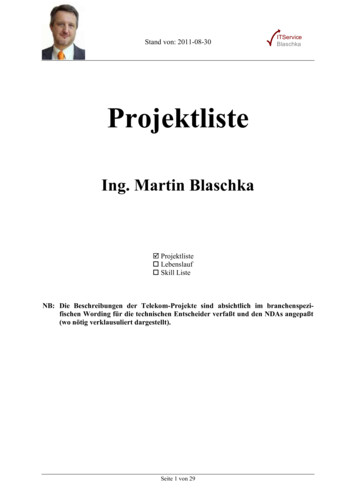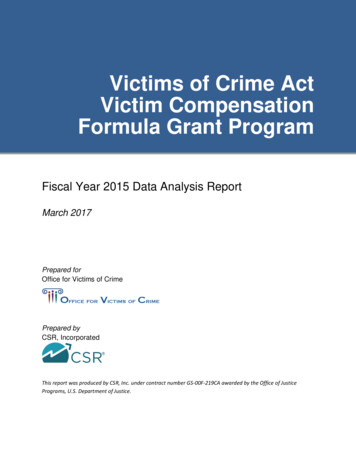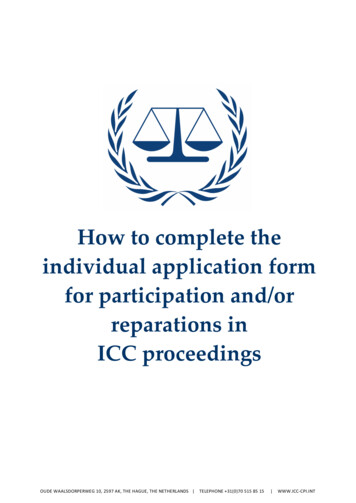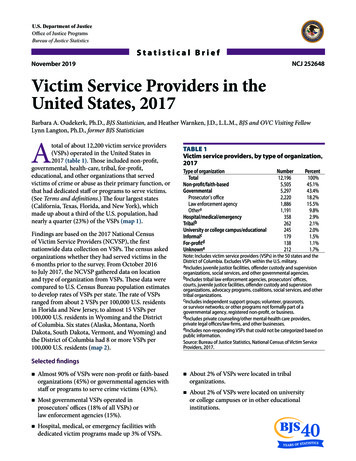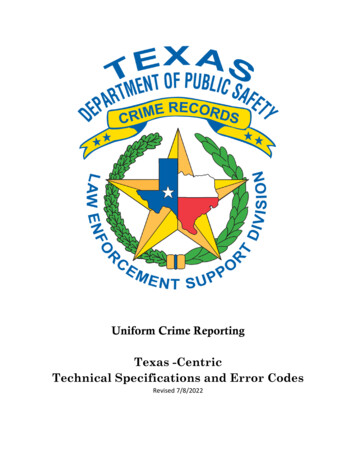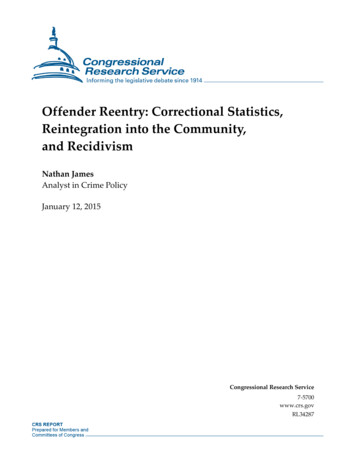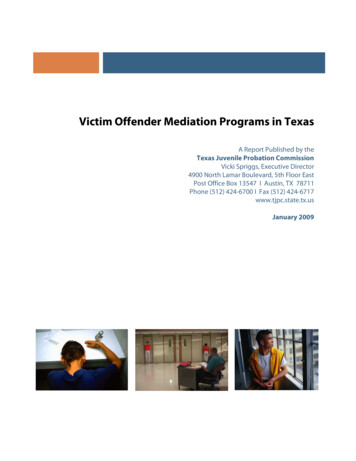
Transcription
Victim Offender Mediation Programs in TexasA Report Published by theTexas Juvenile Probation CommissionVicki Spriggs, Executive Director4900 North Lamar Boulevard, 5th Floor EastPost Office Box 13547 I Austin, TX 78711Phone (512) 424-6700 I Fax (512) 424-6717www.tjpc.state.tx.usJanuary 2009
Summary of ContentsVictim Offender Mediation Programs in Texas . 1Section I. Victim Offender Mediation Background. 1Benefits and Potential Pitfalls . 2Best Practices. 3Section II. Victim Offender Mediation Programs in Texas. 3Section III. Victim Offender Mediation in Dallas, Tarrant, and Travis Juvenile Probation Departments . 7Mediation Outcomes . 10One Year Re-Referral Rate . 10Section IV. Conclusions and Recommendations . 12Conclusion. 12Recommendations . 12Appendix 1. Summary of Victim Offender Programs in Texas . 15Appendix 2. County Location of Dispute Resolution Centers in Texas . 17Sources Consulted . 19
Victim Offender Mediation Programs in TexasThis report is written in response to H.B. No. 2291, relating to a study of established victim offender mediationprograms in Texas’ juvenile probation departments. Section I of this report provides general backgroundinformation on Victim Offender Mediation (VOM), including its benefits, potential pitfalls, and best practicesbased on nationwide research of VOM programs. Section II focuses on VOM programs in Texas juvenileprobation departments. Although there are nine juvenile probation departments with VOM programs, onlythree departments have active programs with over 100 annual referrals. Section III provides VOM programoutcomes for the three departments with active programs serving at least 100 juveniles annually.Information for this report was obtained from the following sources. The Texas Juvenile Probation Commission(TJPC) surveyed Texas’ 166 juvenile probation departments in late 2007. TJPC staff conducted follow-upinterviews with those departments that have a VOM program. Much of the information in Section III, includingoffense, disposition, and re-referral details was obtained from electronic juvenile offender case data that theTJPC collects from juvenile probation departments.Section I. Victim Offender Mediation BackgroundVictim Offender Mediation (VOM) is an alternative approach to punitive, settlement-driven strategies used totreat juvenile delinquency. Whereas traditionally juvenile courts have determined punishment for a juvenile’soffense, VOM empowers the crime victim and offender to resolve their conflict at the community level throughmediated face-to-face dialogue. Dialogue, an essential component of this model, provides both offenders andvictims an opportunity to express their feelings, share their pain (or remorse), ask questions, and dispelstereotypes about each other during a mediation session. Rehabilitation occurs as the juvenile developsempathy for the victim when confronted with the human cost of their offense.VOM stems from the theory of restorative justice, a framework that views the victim, the broader community,and the offender as those harmed by the offense. To repair this collective harm, restorative justice requires theactive involvement of all affected parties to make the offender accountable and to heal the victim. VOMencourages the involved parties to mutually develop and agree on a plan of restitution. This agreement mayinvolve community service, monetary compensation, direct service to the victim, or a combination of each. Anagreement may also include an assurance by the offender to change the behavior that led to the offense orallow the offender to formally express remorse.There are two schools of thought on VOM referral criteria. One believes any case is appropriate for VOM,regardless of the offense, the offender’s age, and the circumstances of the case. The other school believes thatonly more serious cases, such as felony property offenses and some violent offenses, should be referred to VOMso that the program serves as a true diversionary measure from prosecution or deeper penetration of thecriminal justice system.1 The first school of thought seems to prevail in the juvenile justice system nationwidesince VOM has been used primarily to address nonviolent property crimes, minor assaults, and domesticviolence offenses. Referral criteria to VOM in Texas’ juvenile probation departments are discussed in Section II ofthis report.1Mark Umbreit, The Handbook of Victim Offender Mediation: An Essential Guide to Practice and Research (San Francisco: Jossey Bass, 2000), 140.Victim Offender Mediation in Texas1
VOM is typically a four-phase process.2 At intake, referrals to VOM are usually initiated by juvenile probationofficers (JPOs), prosecutors, judges, or victim-assistance advocates, depending on program referral specifications.The second phase involves preparation for mediation. During this phase, a trained and impartial mediator who hasno direct association with either the offender or the victim meets with both parties separately, explains theprocess, listens to each participant’s description of the offense, and then secures consent to participate in theactual mediation session. The third phase of the program is the mediation session where each person tells theirversion of events, asks questions, and discusses emotional and material losses. The victim and offender usuallyhave someone present (a parent or close friend) at the session to provide emotional support. Restitutionagreements are developed at this time. The last phase requires program staff and/or mediator follow-up andmonitoring of the restitution agreement.Benefits and Potential PitfallsNationally many process and outcome studies have been conducted on VOM programs. Although primarily basedon the evaluation of adult VOM programs, research suggests that victim offender mediation is beneficial to boththe victim and the offender. Among the well-established benefits of this program are the high levels of victim andoffender satisfaction with the VOM process.3 Victims appreciate the opportunity to share with the offender theirstory and express the pain suffered from the offense. Consequently, many victims report decreases in anxiety overthe offense and a feeling of closure with the incident. Offenders generally report having a better understanding ofthe effects their offense had on the victim. Additionally, most VOM participants believed the process to be fair,including the restitution agreement reached. These reports are confirmed by the high number (almost 90 percent)of agreements reached during VOM. Of those agreements, about 80 to 90 percent are reported as completed.4Given that the majority of VOM programs require voluntary participation from offenders and victims, these resultsundoubtedly contribute to participants’ high satisfaction levels and fairness perceptions.Summary judgments about the effect of VOM on offender recidivism are complicated by differing definitions ofre-offense and the time-frame researchers use to evaluate re-offenses. For example, some researchers define reoffense as adjudicated guilty, others check for subsequent arrests, while still others define re-offense as aviolation of probation. Overall, research on adult VOM programs nationally reports reduced recidivism when thefollow-up is limited to a period of a year from the initial offense. Generally, the extent of the positive effectdecreases as the time-frame increases.Research also points out the potential pitfalls of VOM programs. In some situations, VOM may actually widen thenet of social control if departments automatically refer minor cases to VOM. In some of these situations, VOMbecomes a more severe sanction, especially if the juvenile’s case would have been dropped or dismissed withsupervisory caution if the VOM program did not exist. Another potential pitfall cited by Professor Mark Umbreitof the University of Minnesota is the “McDonaldization” of VOM.5 McDonaldization occurs when VOM becomesoverly standardized as management seeks to reduce caseloads by quickly processing cases. In doing so,2Umbreit, Mark. The Mediation & Dialogue Process: Phases and Tasks. Center for Restorative Justice & Peacemaking. PPT. n.d.http://rjp.umn.edu/img/assets/19844/Mediation Process Phases Tasks.ppt3Mark Umbreit, Robert B. Coates, and Betty Vos, “The Impact of Victim-Offender Mediation: Two Decades of Research,” Federal Probation 65,no. 3 (2001).4Mark Umbreit, The Handbook of Victim Offender Mediation.5Ibid.Victim Offender Mediation in Texas2
departments may eliminate critical components of this model, such as the mediator’s individual preparatorymeetings with the victim and offender or they may curtail dialogue during the mediation session.Misunderstood differences in communication styles or ways of expressing values because of differences incultural, socioeconomic, geographical, or other backgrounds is another potential pitfall that may undermine aVOM session, and a program, if these differences are not addressed through mediator training and inpreparation meetings with the offender and victim.Best PracticesThe following bullets provide brief descriptions of VOM best practices as identified by national research. Thesebest practices do not necessarily reflect actual practices in Texas’ VOM programs, which are described in Section II. Participation is voluntary. Most researchers agree VOM should require voluntary participation from boththe victim and the offender. Otherwise, participants may not achieve meaningful mediation and empathyfor each other when either party feels coerced into VOM. Offender admits guilt. Most VOM programs require the offender’s admission of guilt prior to mediation.The reasons for this are in line with the goals of restorative justice, whose purpose is to make the offenderaccountable for the offense. It is unlikely the offender will internalize any sense of accountability if he or shehas not admitted guilt, even if the juvenile has been adjudicated guilty. All parties are prepared before mediation. Separate preparatory meetings between the mediator andvictim and the mediator and offender are highly encouraged. These meetings help the mediator assess theparticipants’ attitudes, address expectations, and ensure no one is feeling coerced into VOM. Thesemeetings also help redress the imbalance of power caused by age and communication differences betweenthe offender and the victim, especially if the latter is an adult. Mediators can address these issues throughinformal role-playing that helps prepare both parties for the face-to-face dialogue. Employ a neutral and trained mediator. It is highly recommended that a neutral and well-trainedindividual not involved in the dispute serve as the mediator. Researchers generally do not consider juvenileprobation officers to be neutral mediators, although many programs still employ them in this capacity.Many programs use trained community volunteers from the area’s local dispute resolution center, an optionthat also helps to reduce program costs. Mediator training requirements often vary across programs. Somehave very detailed requirements while others have very general provisions.Section II. Victim Offender Mediation Programs in TexasAlthough VOM has been operating in the U.S. since the 1970s, it is still relatively new to most juvenile probationdepartments in Texas. Of Texas’ 166 departments, only nine reported offering victim offender mediationservices in 2007. As indicated on Table 1 (next page), the majority of VOM programs operating in juvenileprobation departments serve only a few youth annually. Only three of these programs served an average of 100or more juveniles annually. Four departments with VOM programs also offer other restorative justice programssuch as Teen Court, Neighborhood Conference Committees, and/or Victim Impact Panels. In addition to the ninedepartments offering VOM programs in 2007, at least three juvenile probation departments, Lubbock, Nueces,and Hood, are currently developing VOM programs.Victim Offender Mediation in Texas3
Table 1.Texas Juvenile Probation Departments withVictim Offender Mediation Programs in CY ennanMontgomeryTarrantTravisInceptionDateAvg. AnnualParticipantsAverageAgreement own80%98%86%*Includes VOM referrals that never made it to mediation.Source: TJPC survey of Texas juvenile probation departments and interviews with juvenile probation department staff.The referral criteria for VOM vary among the nine juvenile probation departments operating this program. Thedepartments in Montgomery, Tarrant, and Dallas counties allow all offenders, regardless of the offense, toparticipate in VOM. The other departments refer only juveniles who have committed specific offenses to VOM.For example, Travis’ VOM program is used only for juveniles committing domestic violence and propertyoffenses.Various individuals may refer juveniles to VOM, depending on the department’s policies. Probation officers arethe primary source of referral to VOM in all departments, except in Gregg County. Gregg County only conductsmediations when ordered by a judge because of limited staff resources. In addition to probation officers, someVOM programs accept referrals from judges, schools, parents, victims, as well as the offender. Appendix 1contains a table of this information.All departments make VOM participation voluntary for both the victim and the offender. In many cases thecounty District Attorney and the juvenile’s attorney must also consent to mediation. Some departments reportthat the voluntary nature of the program contributes to low participation rates. Participation is also affected bythe use of mediation to determine restitution and community service hours only, meaning mediation is skippedif these are agreed upon before the mediation date.The majority of departments reported that the cost of VOM programs is minimal because of the servicesprovided by the county’s local dispute resolution center (DRC). In addition to training services, grants,fundraising and client fees, these DRCs are also funded by county court fees. Five of the nine departments relyon the county’s local dispute resolution center to recruit and train mediators at no cost to the department. TheDallas and McLennan departments do not use the services of a DRC despite the existence of such anorganization in their county. Instead, they use department staff to conduct the mediations. Appendix 2 lists allof Texas’ dispute resolution centers and their location. Two of the three counties lacking a DRC still rely onvolunteers, but train and recruit mediators differently. Gregg County recruits and trains volunteers from theVictim Offender Mediation in Texas4
community to conduct the mediations for the department. Kendall County’s mediations are conducted by aprofessor from the University of Texas at San Antonio who volunteers for the department. The victim assistancecoordinator at the McLennan juvenile probation department conducts the mediations.In addition to trained and impartial mediators, VOM programs require coordination and management bydepartment staff. These functions are usually performed by staff with other integral departmental duties, such asthe victim assistance coordinator or a juvenile probation officer. Only two counties reported annual operatingcosts for VOM. Not coincidently, these same counties have the largest VOM programs in Texas. Moreinformation on the cost of these is provided below and in Section III.Following is a description of existing VOM programs in Texas’ juvenile probation departments. Appendix 1contains a summary of this information.67 Bexar County Juvenile Probation Department -- The goal of Bexar County’s VOM program is to divert firsttime juvenile offenders referred for minor misdemeanor and property offenses from entry into thejuvenile justice system. Successfully completed agreements release the offender from further obligationsto the department. Referrals to VOM are made by juvenile probation officers, although the offender andvictim must still agree to voluntarily participate. Mediations are conducted by the county’s disputeresolution center, which recruits and trains mediators at no cost to the department. Bexar County reportsvoluntary participation contributes to low program participation rates, especially from the victim who ismost likely to decline VOM. According to staff, offenders in Bexar County have a greater incentive toparticipate because mediation gives them an opportunity to negotiate the amount of their restitution.Bexar Department does not track agreement outcomes, although it is the juvenile probation officer’sresponsibility to ensure the agreement is fulfilled. Department staff report the program’s cost is minimal. Dallas County Juvenile Probation Department -- Dallas County has Texas’ oldest VOM program for juvenileoffenders. The program was originally conceived as a result of the Restorative Justice movement, but nowVOM has become part of a broader program that provides a full range of services including communityservice restitution, job readiness training, and at times, direct service to the victim. Referrals to VOM canbe initiated by the juvenile court judge, the victim, or the juvenile probation officer for any type ofoffense. In practice, however, most referrals to VOM are for property offenses. Participation in theDepartment’s program must be voluntary for all parties. The Department conducts all VOMs “in house”under the supervision of the Mediation Manager. Mediations may be face-to-face or over the telephone.The program’s annual cost is estimated at 58,678, which includes prorated salary and benefits for thedepartment’s mediator, alternative mediator, interpreter services, and the supervisory staff. Gregg County Juvenile Probation Department -- Gregg County had at one time a fairly large VOMprogram, but according to staff, referrals declined significantly with the introduction of ProgressiveSanctions.6 Mediations are conducted by trained volunteer mediators when ordered by a juvenile courtjudge, although the offender and victim must still participate voluntarily. Finding volunteer mediatorsis one of the department’s biggest challenges according to staff.7 Program cost is minimal becauseprogram administration is included with the other duties of the victim assistance coordinator.The department began disposing referrals according to progressive sanctions instead of diverting these to VOM.There is no dispute resolution center that serves Gregg County.Victim Offender Mediation in Texas5
Jefferson County Juvenile Probation Department -- VOM is reserved in Jefferson County for first orsecond time offenders who do not have a record of multiple burglaries or unauthorized use of a motorvehicle, and whose parents express a good faith interest in addressing restitution needs. VOM referralsin Jefferson County can be initiated by police officers, judges, victims, schools, probation officers, or thejuvenile’s parents. In practice, however, most of the Department’s referrals are initiated by a juvenileprobation officer for cases requiring restitution. As with most all other departments, all parties mustvoluntarily participate, and additionally, the offender must have admitted guilt. Mediations arecancelled if restitution is agreed upon before the mediation date. Mediations are conducted by thecounty’s dispute resolution center in person or by telephone. The program has no impact on thedepartment’s budget because the DRC provides mediation services at no cost. Kendall County Juvenile Probation Department -- Kendall County’s VOM program is one of Texas’newest, begun in April 2007. It is operated by the Restorative Justice Board, a multi-agencycollaborative effort among the county’s Sheriff Department, Courts, the Boerne Police Department, andthe Kendall Juvenile Probation Department. The Restorative Justice Board accepts juveniles who havecommitted misdemeanors and C.I.N.S.8 offenses referred by the Kendall Department, as well as by policeofficers, parents, judges, and the schools. Offender and victim participation is voluntary. Mediations areconducted by a criminal justice professor from the University of Texas at San Antonio and are held atthe Kendall County Courthouse or the Juvenile Probation Department. Program costs for 2007 totaled 1,877, which included mediator training and supplies. These costs, however, were absorbed by theBoerne Police Department, the agency currently scheduling mediations. McLennan County Juvenile Probation Department -- McLennan County’s VOM program is known asVictim/Offender Conferencing. Referrals to VOM may be made by the offender’s parents, a probationofficer, or even the offender, but the victim and offender must still participate voluntarily. Referrals tothe program are primarily for property crimes and minor assault offenses. The majority of mediationswere for juveniles that accepted a deferred prosecution agreement that addressed restitution andcommunity service hours prior to the mediation. The department reports that the program’s voluntarynature discourages participation by the offender who often perceives the program as an extrapunishment. Mediations are held at the department and are conducted by the McLennan JuvenileProbation Department’s victim assistance coordinator. The program’s cost is minimal as programcoordination and mediation are included with the duties of the victim assistance coordinator. Montgomery County Juvenile Probation Department -- Referrals to Montgomery County’s VOMprogram are made by the juvenile court judge or the department’s probation officers, althoughparticipation by the offender and victim must be voluntary. The program accepts juveniles with alltypes of offenses, but in practice, most referrals are for theft and property damage and are made withthe goal of arriving at a restitution agreement before the referral is disposed. The agreement is usuallypart of a deferred prosecution agreement. The department’s dispute resolution center recruits andtrains volunteer mediators and conducts the mediations off-site, thus minimizing costs to thedepartment.8C.I.N.S. refers to “Conduct Indicating a Need for Supervision” and includes non-criminal offenses such as truancy, runaway, publicintoxication, inhalant abuse, and certain fineable only offenses that have been transferred to the juvenile courts from a municipal or justicecourt.Victim Offender Mediation in Texas6
Tarrant County Juvenile Probation Department -- VOM referrals in Tarrant County can be initiated by thejuvenile’s parent(s), the judge, district attorney, victim, or the juvenile probation officer for any offenseand at various stages of the juvenile justice process. The victim and offender must agree to participatevoluntarily. Because mediation is offered as part of a larger domestic violence program, many of TarrantCounty VOM participants are referred for family violence offenses. Tarrant County contracts with thecounty’s dispute resolution center to recruit and train volunteer mediators, but the actual mediationsession is conducted at the department under the coordination of the Victim Assistance Unit. Theservices provided by the DRC significantly reduce the program’s cost, which is partly funded by aCriminal Justice Department grant. However, funding sources are aimed at the Tarrant JuvenileProbation Department’s Breaking the Cycle of Violence, a comprehensive program that provides anarray of interventions to address juvenile domestic violence. VOM is only one component of thisprogram. Tarrant County reports its VOM program expanded after the department began schedulingmediation sessions themselves instead of referring these out to the local dispute resolution center. Thelatter used regular mail to schedule mediations, which often led to lengthy timeframes, sometimesmonths, to resolve the issue. Exact program costs are not available since VOM is part of a multi-faceteddomestic violence program. Travis County Juvenile Probation Department -- VOM referrals in Travis County may be court-ordered,requested by a juvenile probation officer, or by the family. All parties participate voluntarily. Theprogram was used initially for property crimes, but began serving juveniles with assault and familyviolence offenses in 1995, which now comprise the majority of VOM referrals. As with Bexar, Jefferson,Montgomery, and Tarrant Counties, Travis County obtains volunteer mediators from the county’s localdispute resolution center, but conducts mediations at the department. The Travis Juvenile ProbationDepartment estimates the cost of their VOM program to be approximately 5,000 annually.Section III. Victim Offender Mediation inDallas, Tarrant, and Travis Juvenile Probation DepartmentsThis section contains information on all Dallas, Tarrant, and Travis juvenile probation department referrals toVOM in fiscal year 2006. In that year, these three counties combined referred 589 juveniles to victim offendermediation for 6229 offenses. Most juveniles referred were Hispanic (38%), followed closely by African Americans(33%), and then by Whites (27%). Seventy-three percent of these juveniles are male.Slightly more than half of the juveniles referred to VOM had no prior referrals, as indicated in the chart thatfollows. Thirty-five percent had one or two prior referrals, while 12 percent had three or more prior referrals tothe juvenile probation department at the time of referral to the VOM program. An examination of thisinformation by department shows greater similarities between the prior referral history of the juveniles referredto VOM by Tarrant and Travis counties. The percentage of Tarrant and Travis County juveniles with no priorhistory and referred to VOM was 66.5 percent and 62.8 percent respectively, whereas the percentage of Dallasjuveniles with no priors was 37.1 percent. The percentage of juveniles with one or two prior referrals for Tarrantand Travis counties was 26.4 percent and 23.9 percent respectively, lower than Dallas’ rate of 47 percent for thiscategory.9Juveniles may have participated in VOM for multiple offense referrals. The primary offense for each referral was used for analysis.Victim Offender Mediation in Texas7
Number of Prior Referrals for Juveniles Referredto VOM in Dallas, Travis, and Tarrant in FY 200612%53%35%No Priors1-2 Priors3 PriorsOverall, the majority (56%) of VOM referrals were for misdemeanor offenses. Table 2 below specifies the type ofoffenses that lead to the VOM program referral. Burglaries were the most common felony offense, the majorityof which were committed by juveniles in the Dallas VOM program (122 out of 131 felony burglaries). Overall,assaults were the most common misdemeanor offense, the majority committed by juveniles in the Tarrant andTravis VOM programs (205 out of 227 misdemeanor assaults).Motor Runaway, 5%3.4%36.6%0.6%7.4%0.2%11.6%1.3%Contempt of MagistrateOrderBurglaryCINSAll SexualAssaultsClass A & B MisdemeanorsAggravatedAssaultFelony OffensesViolation ofProbation OrderTable 2.Offenses Mediated by VOM inDallas, Tarrant, and Travis Juvenile Probation Departments(count and percent)711.1%0.2%Note: Offenses listed were determined at disposition. Offense information for one referral was unavailable.An examination by department of the offenses committed by juveniles referred to VOM reflects differences inoffense referral criteria. For example, the majority (68.6%) of Dallas' total VOM referrals are for felony propertyoffenses. Only 15 percent of the total property offenses are misdemeanor offenses. The offenses of TarrantCounty juveniles referred to VOM are overwhelmingly misdemeanor offenses (84.4%), mainly for assaults. LikeVictim Offender Mediation in Texas8
Tarrant County, Travis County's total VOM r
Post Office Box 13547 I Austin, TX 78711 Phone (512) 424-6700 I Fax (512) 424-6717 www.tjpc.state.tx.us . Research also points out the potential pitfalls of VOM programs. In some situations, VOM may actually widen the . Four departments with VOM programs also offer other restorative justice programs
